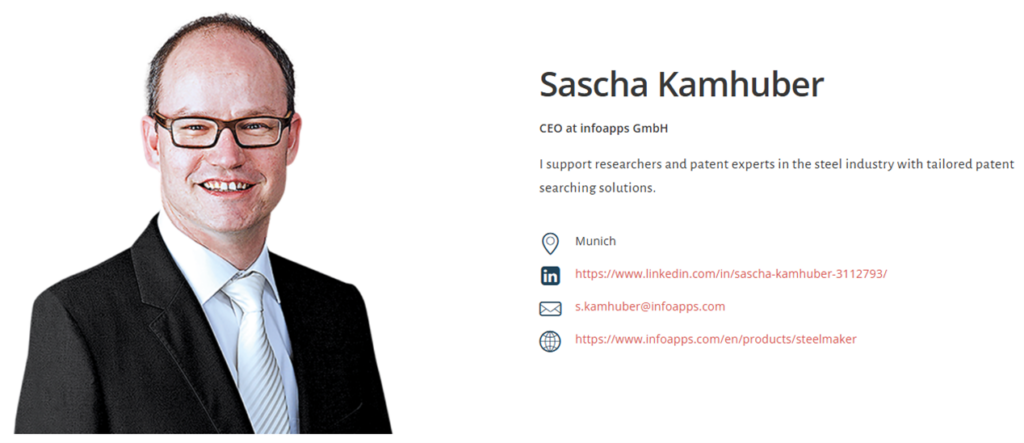Sascha Kamhuber is Subject Matter Expert in the CEIPI-EPO Master of IP Law and Management
Roadmapping👉 A strategic tool visualizing plans and goals to align teams and stakeholders. serves as a compass for organizations navigating the turbulent waters of technological advancement and market demands. However, the process is fraught with challenges, particularly in industries where innovation👉 Practical application of new ideas to create value. cycles are rapid and intellectual property👉 Creations of the mind protected by legal rights. (IP) landscapes are densely populated. This blog post is a summary of the third module of the CEIPI-EPO Master’s Program in IP Law and Management (MIPLM) on the topic of Technology Roadmapping. An overview of this lecture is available here:
This blog post explores the hurdles companies face in effective roadmapping and the intricacies of integrating patent👉 A legal right granting exclusive control over an invention for a limited time. data into these strategies and offers—exemplified by Sascha Kamhuber’s patent research methodology in the steel industry—a blueprint for overcoming these obstacles. Sascha Kamhuber is a Subject Matter Expert for patent information in the steel industry at the CEIPI-EPO MIPLM.
The Challenges of Roadmapping in Industrial Innovation
Roadmapping is a critical tool for aligning R&D efforts with business objectives, yet its implementation is far from straightforward. Companies must balance competing priorities, anticipate market shifts, and manage cross-functional collaboration—all while ensuring their strategies remain agile enough to adapt to disruptions.
- Technological and Market Uncertainty
Emerging technologies like AI and quantum computing introduce unknowns that complicate long-term planning. For instance, early entrants in the personal digital assistant (PDA) market, such as Apple’s Newton, struggled because enabling technologies (e.g., batteries, handwriting recognition software) were immature, leading to costly delays. Roadmaps must account for such uncertainties, but predicting which technologies will dominate—or how customer needs will evolve—is inherently risky. The shift from analog to digital mobile technology in the 1990s, which caught Motorola off guard while propelling Nokia to dominance, underscores the consequences of misjudging technological trajectories. - Cross-Functional Alignment
Effective roadmapping requires seamless coordination between R&D, marketing, legal, and supply chain teams. Misalignment often arises from conflicting priorities: engineers may prioritize technical perfection, while marketing pushes for rapid launches. The stage-gate process, used by companies like Exxon, mitigates this by incorporating checkpoints to ensure alignment. However, siloed departments can still derail progress, as seen in Motorola’s failure to pivot from analog to digital mobile technology despite having the requisite patents. - Resource Allocation and Scalability
The “innovation funnel” concept reveals that only a fraction of ideas become viable products. For example, out of 3,000 raw ideas, just one might reach commercialization. Allocating resources to high-potential projects while avoiding overcommitment to unproven technologies is a delicate balance. Kodak’s inability to monetize its digital imaging patents before its decline illustrates the risks of misaligned resource allocation. Startups and SMEs face amplified challenges, as limited capital forces them to prioritize short-term gains over long-term innovation. - Adapting to Disruptive Technologies
Disruptive innovations, such as digital photography’s displacement of silver halide film, can render existing roadmaps obsolete overnight. Companies often fall victim to the “innovator’s dilemma,” where focus on current customer needs blinds them to emerging threats. The steel industry, for instance, faces pressure to adopt sustainable production methods while maintaining cost efficiency—a challenge requiring roadmaps that integrate both incremental and radical innovations.
IP Management Challenges in Technology Roadmapping
Integrating patent information into roadmaps adds another layer of complexity. Intellectual property is both a shield and a sword, but leveraging it strategically demands navigating legal, technical, and operational hurdles.
- Patent Thickets and Freedom-to-Operate (FTO) Risks
In crowded sectors like telecommunications or advanced materials, overlapping patents create dense “thickets” that stifle innovation. Conducting FTO analyses to avoid infringement is resource-intensive, particularly for SMEs. Siemens VDO’s 3D navigation system, for example, required late-stage redesigns due to overlapping patents, inflating development costs. In the steel industry, where process innovations are often incremental, navigating these thickets is critical to avoiding litigation and maintaining competitive margins. - Global IP Fragmentation
Patent laws vary widely across jurisdictions, complicating international expansion. A design patent valid in the EU might not hold in Asia, forcing firms to manage regional portfolios. For instance, differences in software patent👉 Protection of computer-implemented inventions, as a technical solution realized by software eligibility between the U.S. and Europe require tailored strategies. This fragmentation increases costs and delays, particularly in industries like steel, where innovations in alloy compositions or recycling methods must be protected across multiple markets. - Balancing Disclosure and Protection
Patents require disclosing technical details, which competitors can exploit to design around claims. Startups often over-patent trivial features or under-protect critical IP, leaving vulnerabilities. Nokia’s strategic patenting during its transition from rubber boots to mobile dominance in the 1990s exemplifies how to protect core innovations without overexposure. However, in industries with long product lifecycles, like steel, premature disclosure can erode competitive advantages. - Lifecycle Management and Cost
Patents have finite lifespans, and their value fluctuates with market dynamics. Effective lifecycle management involves renewing high-value patents, abandoning underutilized ones, and licensing👉 Permission to use a right or asset granted by its owner. non-core IP. IBM’s $27 billion annual licensing revenue highlights the potential of strategic IP monetization. Yet, for capital-intensive industries like steel, the cost of maintaining global portfolios often strains budgets, necessitating rigorous prioritization.
👉 https://profwurzer.com/the-power-of-road-mapping-and-patent-information
Sascha Kamhuber’s Patent Research Solution: A Steel Industry Case Study
Sascha Kamhuber’s methodology for integrating patent research into technology roadmapping addresses these challenges head-on, offering a model for industrial sectors grappling with IP complexity.
The Steel Industry’s Innovation Crossroads
Steel is a traditional industry facing dual pressures: reducing carbon emissions and adopting Industry 4.0👉 Usage of digital technologies to create smart, connected manufacturing systems. technologies. Kamhuber’s approach recognizes that roadmapping in this sector must reconcile incremental process improvements (e.g., energy-efficient smelting) with disruptive innovations (e.g., hydrogen-based steel production). By embedding patent analytics into each stage of the roadmap, his method transforms IP data from a legal obligation into a strategic asset.
Key Components of the Methodology:
- Accessibility of Patent Information
The methodology simplifies complex patent landscapes, making them more accessible to engineers without extensive legal expertise. By focusing on the material science aspects detailed in patents—such as compositions, properties, and manufacturing methods—it enables engineers to directly apply this knowledge to their R&D efforts. - Material Science as a Foundation
Patents in material science often include detailed descriptions of innovative materials, their properties, and applications. The methodology leverages this information to guide engineers in developing new products or improving existing ones. For example, analyzing patents related to corrosion-resistant alloys can inspire designs for more durable components in industries like automotive or aerospace. - Integration with Technology Roadmapping
Patent information is systematically incorporated into technology roadmaps to identify emerging trends and white spots in material science innovation. This helps companies anticipate market needs and align their R&D strategies with future technological advancements. - Focus on Practical Application
The methodology emphasizes actionable insights rather than theoretical analysis. Engineers use patent data to solve specific technical problems, refine processes, or develop new materials that comply with existing IP constraints while fostering innovation. - Enhancing Collaboration
By presenting patent information in a user-friendly format, the approach fosters collaboration between engineers, legal teams, and business units. This ensures that innovations are both technically feasible and legally protected, streamlining the path from concept to commercialization.
Conclusion
Roadmapping in industrial sectors is a high-stakes balancing act, requiring companies to anticipate technological shifts, allocate resources wisely, and navigate IP complexities. Sascha Kamhuber’s patent research methodology exemplifies how integrating IP strategy👉 Approach to manage, protect, and leverage IP assets. into every phase of roadmapping can transform challenges into opportunities. By leveraging data-driven insights, fostering cross-functional collaboration, and aligning IP management👉 Strategic and operative handling of IP to maximize value. with business goals, organizations can not only avoid pitfalls but also drive sustainable innovation. In industries like steel, where tradition and transformation collide, such approaches are not just advantageous—they are essential for survival.
Subject expert
 Visit my expert profile on the digital IP lexicon 👉 🔗𝗱𝗜𝗣𝗹𝗲𝘅
Visit my expert profile on the digital IP lexicon 👉 🔗𝗱𝗜𝗣𝗹𝗲𝘅
